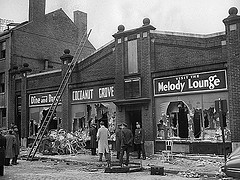Cocoanut Grove fire facts for kids

The Shawmut Street side of the Cocoanut Grove nightclub after the fire
|
|
| Lua error in Module:Location_map at line 420: attempt to index field 'wikibase' (a nil value). | |
| Date | November 28, 1942 |
|---|---|
| Time | Around 10:15 pm |
| Location | Bay Village, Boston, Massachusetts, U.S. |
| Coordinates | 42°21′0″N 71°4′6″W / 42.35000°N 71.06833°W |
| Cause | Ignition of decorative cloth |
| Deaths | 492 |
| Non-fatal injuries | 130 |
| Suspects | Barney Welansky |
| Charges | Manslaughter, numerous building code and safety violations |
| Verdict | Guilty |
| Convictions | Manslaughter |
The Cocoanut Grove fire was a nightclub fire which took place in Boston, Massachusetts, United States, on November 28, 1942. It is the deadliest nightclub fire in U.S. history, claiming 492 lives, and the second-deadliest single-building fire.
The Cocoanut Grove was one of Boston's most popular nightspots, attracting many celebrity visitors. It was owned by Barnet "Barney" Welansky, who was closely connected to the Mafia and to Mayor Maurice J. Tobin. Fire regulations had been flouted: some exit-doors had been locked to prevent unauthorized entry, and the elaborate palm tree décor contained flammable materials. The air-conditioning used flammable gas due to wartime shortage of freon.
During the first Thanksgiving weekend since the U.S. had entered World War II the Grove was filled to more than twice its legal capacity. The fire was initiated by an electrical short and fueled by methyl chloride in the air conditioning unit. Flames and smoke spread rapidly through all areas of the club, and people were unable to escape due in part to locked exit doors. Blame was directed at Welansky for violation of standards; he served nearly four years in jail before being released just weeks before his death.
Local hospitals were especially well prepared to treat the casualties having been rehearsing emergency drills in response to possible wartime attacks on the East Coast. The crisis demonstrated the value of the new blood banks and stimulated important advances in the treatment of burn victims.
Following the tragedy, many new laws were enacted for public establishments, including the banning of flammable decorations, a provision that emergency exits must be kept unlocked (from the inside), and that revolving doors cannot be the sole egress.
Memorials
In 1993, the Bay Village Neighborhood Association installed a memorial plaque in the sidewalk—crafted by Anthony P. Marra, youngest survivor of the Cocoanut Grove fire—next to the location where the club formerly stood:
In memory of the more than 490 people who died in the Cocoanut Grove fire on November 28, 1942. As a result of that terrible tragedy, major changes were made in the fire codes, and improvements in the treatment of burn victims, not only in Boston but across the nation. "Phoenix out of the Ashes"
In 2013, a short street running through the former site of the Cocoanut Grove, and previously named Shawmut Street Extension, was renamed Cocoanut Grove Lane.
The plaque has been moved several times to some controversy. A committee has been formed to build a more substantial memorial.
The Cocoanut Grove fire was the second-deadliest single-building fire in American history; only the 1903 Iroquois Theatre fire in Chicago had a higher death toll, of 602. It was only two years after the Rhythm Club fire which had killed 209.
See also
 In Spanish: Incendio del Cocoanut Grove para niños
In Spanish: Incendio del Cocoanut Grove para niños


